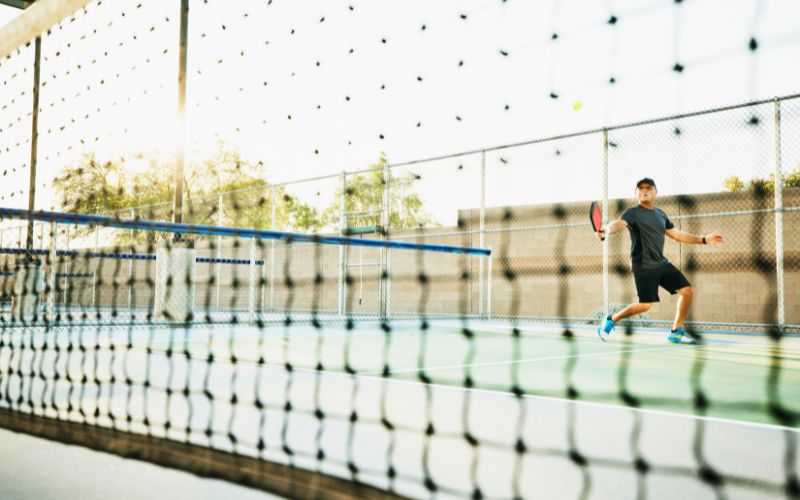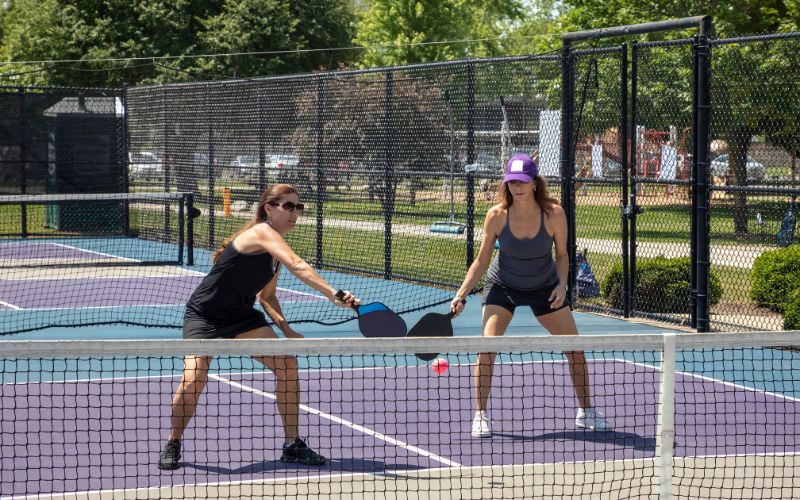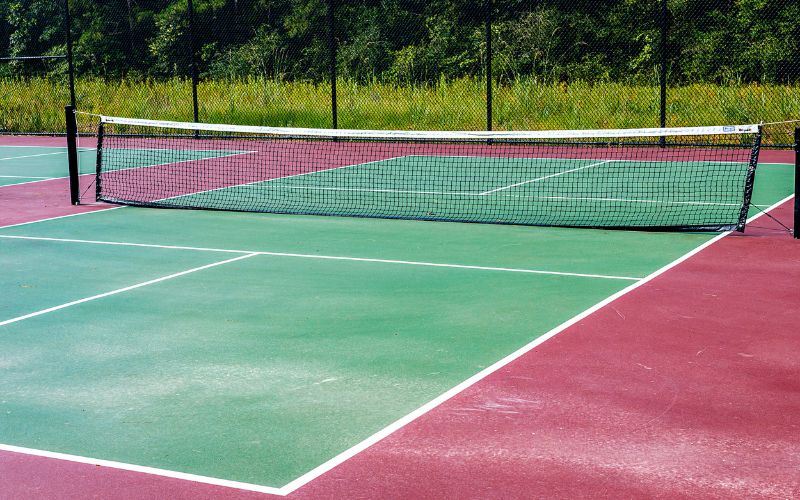Pickleball and tennis are two popular racket sports enjoyed by people of all ages and skill levels. While they share some similarities, one notable difference is the height of the net. In this article, we’ll delve into the nuances of net height in pickleball and tennis, exploring why it matters, how to measure for the correct net height, and much more.
Are Pickleball Nets the Same Height as Tennis Court Net?
Pickleball nets are not the same height as tennis court nets. There is a distinct difference in the net height between these two sports. In pickleball, the net is set at a lower height compared to a tennis net.
Pickleball is played with a net that is placed at a height of 36 inches (91.4 cm) at the sidelines and 34 inches (86.4 cm) at the center. This lower net height in pickleball is one of the factors that make the game more accessible to a wider range of players, including those who may have mobility issues or who are transitioning from other sports.
In contrast, a standard tennis net is much higher, with the net’s center measuring 3 feet (36 inches or 91.4 cm) high. The difference in net height is one of the fundamental distinctions between the two sports, as it affects the style of play and the dynamics of the game.
How to Measure for the Correct Pickleball Net Height
Achieving the correct net height in pickleball is essential to ensure a fair and enjoyable game. We’ll provide you with a step-by-step guide on how to measure and set up your pickleball net.
Measuring for the correct pickleball net height is crucial to maintain the integrity of the game and ensure a level playing field for all players. Fortunately, it’s a relatively straightforward process. Here’s a step-by-step guide to help you get it right:
Step 1: Gather Your Equipment Before you start, make sure you have the necessary equipment ready. You’ll need a measuring tape, a level, and, of course, a pickleball net. The standard height for a pickleball net is 36 inches (or 91.4 cm) at the sidelines and 34 inches (or 86.4 cm) at the center.
Step 2: Locate the Correct Positions Position your pickleball net in the center of the court. To find the correct spot, measure the width of your court, which should be 20 feet for a singles court and 44 feet for a doubles court. Mark the center point.
Step 3: Adjust the Height Now, it’s time to adjust the height of the net. For singles play, the net should be set at 36 inches at the sidelines and 34 inches at the center. For doubles play, the height remains the same.
Step 4: Leveling Ensure that the net is level. Place a level on top of the net, and adjust it until the bubble in the level is centered. This ensures that the net is perfectly horizontal.
Step 5: Tighten the Net Make sure the net is securely fastened to the net posts, and it is taut. It should not sag or droop. A tight net ensures that the ball bounces consistently.
Step 6: Double-Check the Height Once you’ve made all the necessary adjustments, double-check the net’s height. It should meet the official standards of 36 inches on the sides and 34 inches at the center. Use your measuring tape to confirm the height.
Step 7: Test the Net Before you start your game, it’s a good idea to do a quick test. Stand at the net and hit a few balls over it to ensure that it’s at the right height and provides a fair challenge to both you and your opponents.
Width Differences Between Pickleball and Tennis Nets
Pickleball Net Width: A standard pickleball net is designed to be 22 feet wide. This width is consistent for both singles and doubles play. The 22-foot width ensures that the net adequately covers the pickleball court dimensions, dividing it into two halves for both sides of the court.
Tennis Net Width: In tennis, the net is notably wider compared to pickleball. A standard tennis net measures 42 feet in width, which is significantly wider than the pickleball net. Tennis courts are designed for both singles and doubles play, and the broader net accommodates the wider court dimensions.
Why the Difference Matters: The variation in net width is due to the different court sizes in pickleball and tennis. A pickleball court is 20 feet wide for singles and 44 feet wide for doubles, while a tennis court is 27 feet wide for singles and 36 feet wide for doubles. To maintain fair play and ensure that the net covers the court appropriately, the net width for each sport is adjusted accordingly.
Choosing the Right Net: When selecting a net for your game, it’s crucial to pick one that matches the sport you’re playing. Pickleball nets are narrower, ensuring that they are the correct width for pickleball courts. Tennis nets, on the other hand, are wider to suit the dimensions of tennis courts. Using the appropriate net for each sport is essential for an authentic and enjoyable experience.
How to Choose the Right Net for Your Pickleball Game
Selecting the appropriate pickleball net is vital for a smooth and enjoyable game. We’ll guide you through the factors to consider when choosing a net for your pickleball matches.
Pickleball Net Height vs. Tennis Net Height
Here, we’ll take a closer look at the specifics of pickleball net height and how it compares to the height of a tennis net.
1. Material and Durability: Pay attention to the net’s material and build quality. Look for a net made from durable materials that can withstand the rigors of outdoor play. High-quality materials not only ensure longevity but also maintain consistent tension for a fair game.
2. Portability vs. Permanent Nets: Decide whether you need a portable or permanent net. Portable nets are easy to set up and take down, making them a great choice for those who play pickleball in different locations. Permanent nets, on the other hand, are designed for more long-term setups, often found in dedicated pickleball courts.
3. Net Height Adjustment: Some pickleball nets come with adjustable net heights. This feature can be handy if you plan to play both singles and doubles games. Ensure that the net you choose allows you to easily adjust the height to meet your specific needs.
4. Easy Setup: Consider how easy it is to set up the net. Look for a net that comes with clear instructions and a user-friendly assembly process. Quick and hassle-free setup ensures that you spend more time playing and less time preparing.
5. Regulation Compliance: If you’re planning on competitive play or tournaments, make sure the net complies with official regulations and standards. Regulation nets will ensure that your games are in line with the rules, providing a fair playing experience.
6. Reviews and Recommendations: Before making a final decision, read reviews and seek recommendations from experienced pickleball players or organizations. Their insights can help you make an informed choice and point you in the direction of well-regarded net brands and models.
7. Budget: Lastly, consider your budget. Pickleball nets come in a range of price points, and while it’s essential to get a quality net, you can find options that suit your budget without compromising on durability and performance.
How Does the Dip At The Center of the Net Affect Each Sport?
The dip at the center of the net is a unique feature in both pickleball and tennis, and it has a significant impact on how each sport is played. Let’s delve into how this dip affects each sport individually:
In Pickleball
In pickleball, the net’s dip in the center is intentionally designed to be lower than the standard height at the sidelines. The center of the net is set at 34 inches (86.4 cm), while the sides remain at 36 inches (91.4 cm). This design affects the game in several ways:
Strategy: The lower center of the net encourages players to engage in “dinking” rallies, where the ball is hit softly over the net. The dip makes it more challenging to execute aggressive shots, promoting strategic and patient play.
Placement: Players need to be precise in their shots to clear the lower center of the net while keeping the ball within the boundaries. This adds an element of finesse to the game.
Control: The dip forces players to maintain better ball control, as hitting too hard or too high over the center can result in the ball going out of bounds.
In Tennis
Tennis nets also have a dip at the center, but the effect is somewhat different due to the sport’s dynamics:
Serve and Volley: In tennis, the dip at the center of the net is a consideration when players engage in serve-and-volley tactics. A lower center allows for more aggressive net play, encouraging players to approach the net after their serve.
Net Play: The dip at the center can lead to more varied net play, with players using it strategically to their advantage. It’s a key element in net exchanges during the game.
Challenges for Baseline Players: Players staying at the baseline might sometimes have to contend with the net’s dip when attempting passing shots, requiring them to adjust their angles and timing.
Rounding Up: The Main Differences Between Pickleball Nets vs Tennis Nets
In the final section, we’ll summarize the key distinctions between pickleball and tennis nets, providing a comprehensive overview of the topics covered in this article.
Remember that understanding the nuances of net height in both sports is crucial for enjoying pickleball and tennis to the fullest. Whether you’re a seasoned player or a newcomer, this knowledge will enhance your appreciation of these exciting racket sports. Get ready to elevate your game!
FAQs about Pickleball and Tennis Net Heights
1. Are Pickleball Nets the Same Height as Tennis Court Net?
No, they are not. Pickleball nets are set at a lower height compared to tennis nets. In pickleball, the net is 36 inches at the sidelines and 34 inches at the center. In contrast, a standard tennis net’s center measures 36 inches high.
2. How to Measure for the Correct Pickleball Net Height?
Follow these steps: Gather equipment, locate the center, adjust the net height, ensure it’s level, tighten the net, double-check height with a measuring tape, and test the net before playing.
3. What Are the Width Differences Between Pickleball and Tennis Nets?
A standard pickleball net is 22 feet wide for both singles and doubles play, while a tennis net measures 42 feet in width. The variation aligns with the different court sizes in each sport.
4. How to Choose the Right Net for Your Pickleball Game?
Consider factors like material durability, portability vs. permanence, net height adjustment, ease of setup, regulation compliance, reviews, recommendations, and budget.
5. How Does the Dip At The Center of the Net Affect Each Sport?
In pickleball, the lower center promotes strategic play and precision. In tennis, it affects serve-and-volley tactics, net play strategies, and challenges for baseline players.





